Family : Muscicapidae

Text © Dr. Gianfranco Colombo

English translation by Mario Beltramini
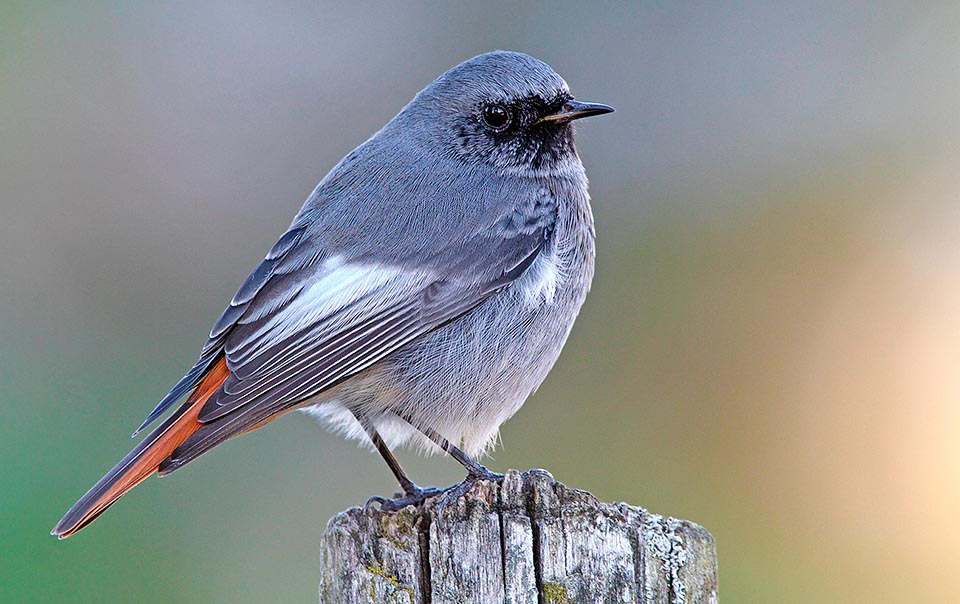
Male in nuptial livery of Black Redstart (Phoenicurus ochruros), palearctic species with a vary vast range extending up to the boundary with China and the North Africa © Luigi Sebastiani
To maintain that a war has favored the territorial expansion of a bird would appear a nonsense but some evidences prove that something has occurred during the last war period. Not that an animal has taken part to the conquest of a country, sustained by an invading enemy or that it has been sent, disguised, to invade an enemy area. Far from that! Surely, it is not a behavior of a being that does not know the meaning of these atrocities even if in the old North European tradition, another bird, the Bohemian waxwing (Bombycilla garrulus) had already earned the shocking and involuntary epithet of doom and human misdeeds. Called in German Kriegvogel, bird if the war, and in Holland Pestvogel, bird of the plague, already from the name its arrival in foreign lands did not promise anything good!
Yet, it has happened, in particular in North Europe that a small bird, that only exceptionally was sighted in the population centres, suddenly began very rapidly to occupy them systematically finding itself in complete ease.

The female, uniformly brownish grey, has a modest livery: the white specula on the wings and the facial mask are absent, but remains the orange of the tail © Jiří Bohdal
The terrible bombings suffered from the English cities during the World War II and in particular London and other industrial centres, caused the destruction of an unbelievable number of dwellings and mountains of rubble everywhere, creating a bleak environment to seem under certain aspects, for this small bird living in the mountains, an already known environment of loose rocks, of steep walls, of ruins of landslides thrown like a cascade one on the other, and an endless series of cracks, fissures and crevices, usual to its habits.
It was like this that in the forties the English cities were invaded by an army well different from the military one, an unarmed and not hostile army that perhaps has cheered with a rather farraginous song, but relatively melodic, a world of destruction and silence, of ruins and of deads. That was the Black redstart (Phoenicurus ochruros Gmelin, 1774) a pretty and elegant small bird assigned to the order of the Passeriformes and to the family of the Muscicapidae the group including the flycatchers of the old world.
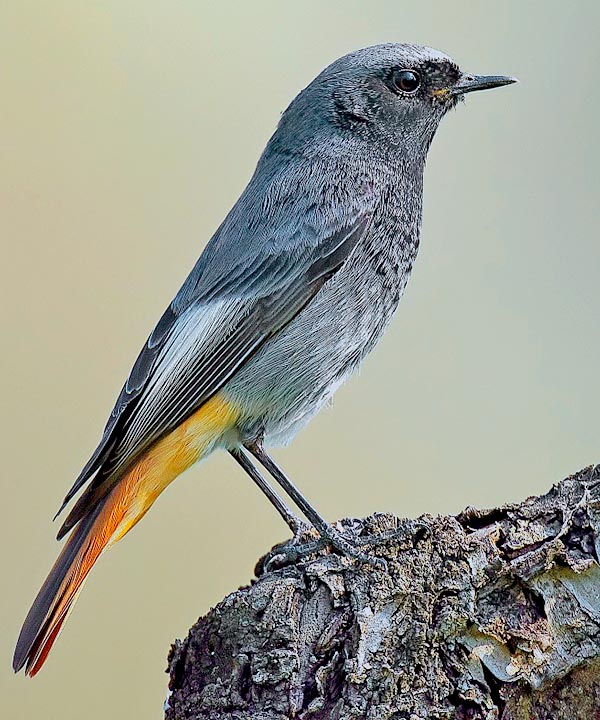
The males distinguish from the congener Phoenicurus Phoenicurus as the red orange chest is absent © Antino Cervigni
Initially inhabitant of barren cliffs, steep and rocky slopes, quarries and wild areas, it found available a new and vast range, uniform and even more suitable to its exigencies. It adapted perfectly and with extreme rapidity to the new habitat, so much to become a small bird common in the inhabited centres of those years.
Then it happened that the reconstruction began to evict reluctantly these small birds that now had become accustomed to their new habitat but, instead of going away from the cities, now used to cohabit with the humans, tried to reconquer them in another way, taking possession of warehouses, of abandoned houses, of monuments, of docks and of any other suitable place.
Then a new and subsequent phase of restructuration did occur, more modern and actual, with different architectures and for them little cozy but, tireless, they have resisted and nowadays they live in any inhabited centre though congested by the traffic and tormented by an everyday life at times impossible even for the human being itself.
All this to show how is flexible the animal world and how each one of its members knows how to survive and to find alternative solutions in every adventure where it has gone. Evolution, nothing but evolution!
Small bird quite similar to its congener Redstart (Phoenicurus phoenicurus) typical summer visitor and nesting in the areas of the Palearctic, the black redstart is to be considered as the winter equivalent of its close relative and practically in the bad season, instead of migrating beyond the Sahara in order to escape the winter rigors, it installs in the territories left free by the first, creating an overcrowding with the arrival of the North European migrating cousins. Though partially overlapping in the habitats also during the nesting period, the two species have however some specific exigencies that often keep them at a certain distance, placing one, the black redtsart, high in mountains and in rather barren and cool environments and the common redstart in woody and milder areas. Anyway, the inhabited centres of all Europe, particularly the North-European ones, seem to have enticed both species that often get to cohabit among the walls of the same city.
All common names given in Europe perfectly reproduce the colours of the livery of this small bird. In English, Black Redstart; in German, Hausrotschwanz; in Spanish, Colirrojo Tizón; in French, Rougequeue noir and in Portuguese, Rabirruvio-preto. Although all these have faithfully taken the colours proposed by the livery of this small bird, there is no doubt that the vulgar Italian name, Codirosso spazzacamino, is the most folkloric seen that in order to distinguish it from the cousin, almost similar, they have … made it passing through a fireplace, rightly turning it black like a chimney-sweeper!
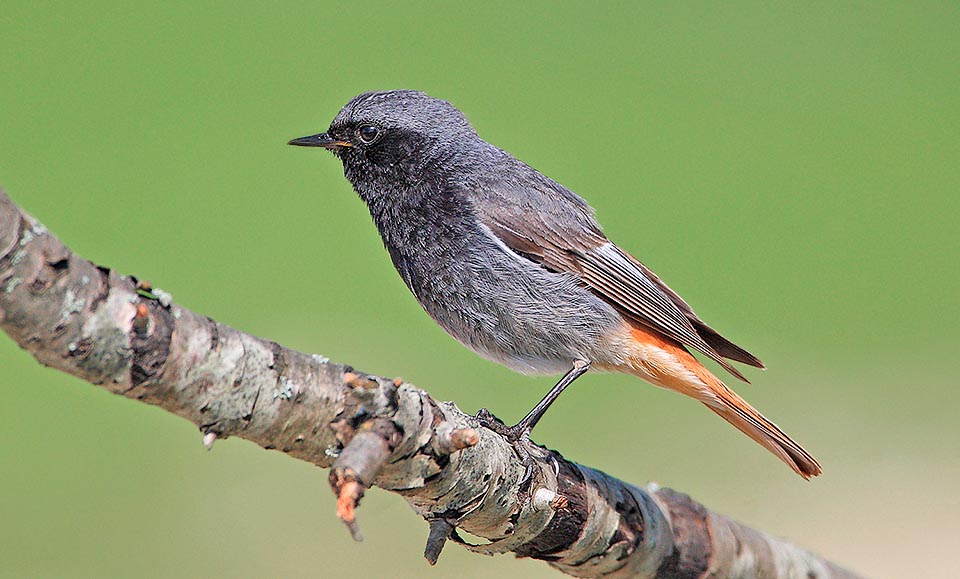
Typical inhabitant of rocky hills with steep slopes, Phoenicurus ochruros has anthropized during the last World War, nesting among ruins of bombings © Luigi Sebastiani
The etymology of the scientific name derives the genus Phoenicurus from the combination of two Greek terms “phoinix” = purple red and “ouros” = tail and the species “ochruros” from the merger always in the same language of “okhros” = ochre, pale yellow and “ouros” = tail. Minor and personal interpretations by the classifier, concerning the real colour of the tail.
Zoogeography
The black redstart is an inhabitant of the Palearctic and has a vast territory going from the coasts of the Atlantic Ocean eastwards to reach, through the central-Asian plains, the boundaries with China touching south the Middle East, Anatolia, the Caucasian region and to graze the big Asian mountain chains. It is present with various nuclei also in north-western Africa, on the mountains of the Moroccan/Algerian Atlas. The populations living the north of the range touching the coasts of the Baltic Sea , the limits of Central and North Europe and the corresponding ones in the Asian regions, are regular migrants and during the winter they spend the bad season at lower and milder latitudes, reaching in the coldest periods even the African coasts, for the European ones, and the Indian subcontinent for the Asian ones.

The Phoenicurus ochruros lays 4-7 eggs, brooded only by the female forabout two weeks. They are not light blue, loke those, very showy, of the Phoenicurus phoenicurus, but uniformly white © Museo Civico di Lentate su Seveso
The southernmost populations of the range are almost sedentary and perform limited and short range migrations, accentuating more intense altitude movements, with displacements that see populations of the high mountain going down in the underlying valleys looking for more tolerable climates.
Ecology-Habitat
The black redstart does not love woods and forests with thick vegetation and also completely barren areas such as prairies, intensive farming areas and quagmires. It is a typical inhabitant of rocky hills with steep slopes, with crushed rocks scattered in the meadows at the foot of cliffs, steep hillsides even of mere rock, mountain zones of whatever height but also at very high altitudes that in Europe reach 3000 m and on the Himalayan chains even to more than 5.000 m.
Also in the cities it loves the areas with old constructions, industrial sheds, abandoned houses, churches, not particularly disturbed corners or peripheral locations or small inhabited country centres.
The black redstart is also a very shy bird, but when compared to its close congener, the common redstart, it would appear a little more expansive and does not skimp on showing in any moment of the day perched on the eaves or on a chimney or on any well in sight place, wagging the tail with its usual quivering and the unrestrainable vibration of the body.
It is very territorial and doggedly defends its range.
Only during the time of nesting period it emits its usual and persistent “tic tic tic” of warning as soon as it sees the approaching of some danger or intruder whilst in winter, when is a guest in the southern Europe cities, is a practically dumb small bird and replaces the absence of voice with a greater frenzy of the body.
Morpho-physiology
Also the black redstart like all muscicapids of the old world, has the same size of its congeners even if at times it assumes positions giving the impression of being more slender and elongated than what it is, being actually slightly more rounded and bigger. It is about 15 cm long, with a weight of 16-17 g and a wingspan around the 25 cm. Hence, perfectly in line with the other congeners. Let us indulge in the now old sartorial joke … that probably the grey colour slims. It is a polytypic species with some subspecies that evidence very light differences in the colouration of the livery. The typical male has a widespread slate grey colour wholly covering the upper and lower parts of the body leaving in evidence a black mask covering the fore part of the face up to the ocular line, just hinted under the throat.
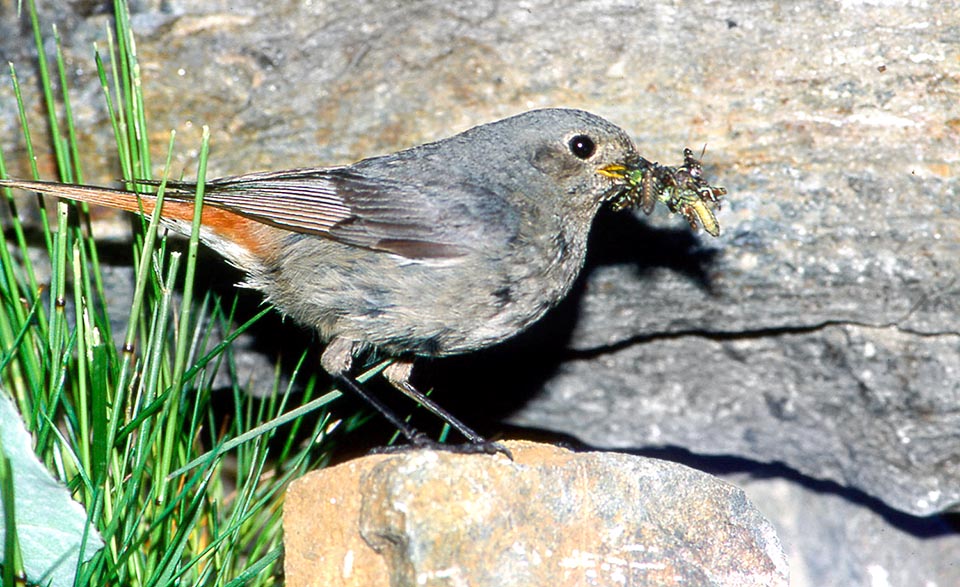
Female after shopping, back to nest with the bill full of food. In the reproductive season, the black redstart hunts all insects, larvae included, spiders, small molluscs and worms, for an adequate protein input to the progeny but in autumn-winter its diet changes and looks also for sweet fruits and small seeds © Museo Civico Lentate Seveso
The flight feathers are black and have on the upper part a whitish speculum well characteristic and identifier of the species. The tail and the rump are of a lively orange colour with blackish central rectrices. The first year old young males even if already nesting, do not evidence always so lively colours as the mature subjects, in fact the livery will get its vividness over the years.
The female, quite similar to that of the Common redstart (Phoenicurus phoenicurus) has uniformly very soft grey/brownish colours and does not have any facial mask and not even whitish specula on the wings but also has an orange tail somewhat less lively in the colours. By the first flight the youngs are completely blackish, livery they will lose with the autumn partial moulting to become quite similar to a female with winter livery. The reddish tail is however immediately quite evident.
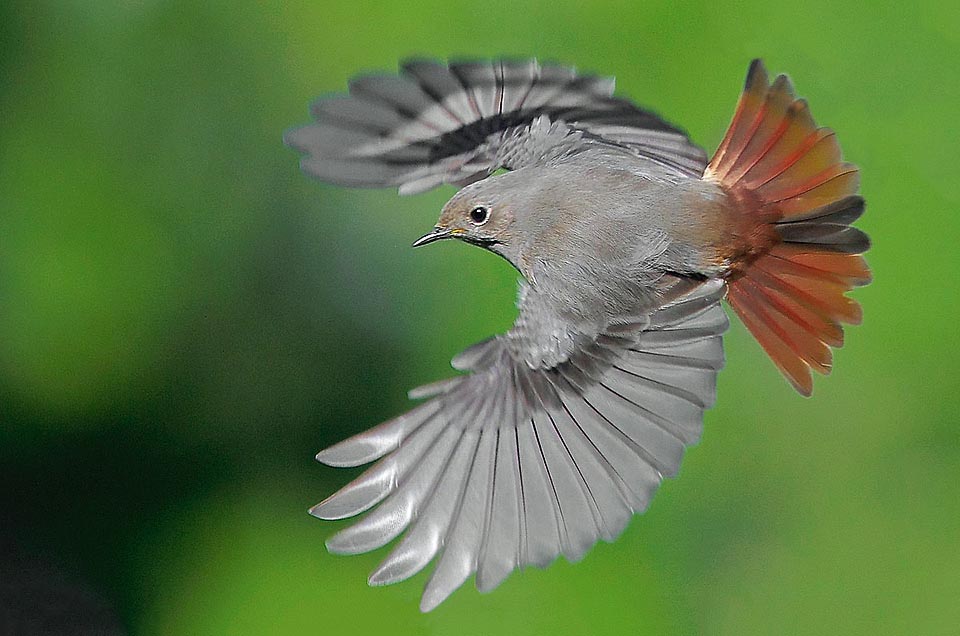
The fast and zigzagging evolutions of this small bird are truly unbelievable. Quite a few flying insects can get away when this small predator is nearby © Aldo Contu
Various subspecies are scattered in the Asian range, among which the Phoenicurus ochruros rufiventris and th Phoenicurus ochruros phoenicuroides both with abdomen and chest totally of lively reddish colour.
Ethology-Reproductive Biology
In its wild environment the black redstart nests in any available hole, crack or fissure, on a steep vertical rocky cliff or under a rock, on a steep mountain foot or inside a cavern. In the anthropized sites it adapts to any shelter that may reproduce the same situations, hence on a beam of a porch, under a tile, in the toolshed in the garden or even in a nestbox. The couple is monogamous for the nesting season. Only the female cares the construction of the nest, carrying herbs, rootlets and moss and furnishing the interior with more fine and soft material and feathers too. 4 to 7 white eggs are laid, contrarily to the common redstart where they are light blue, that are brooded only by the female for about two weeks.
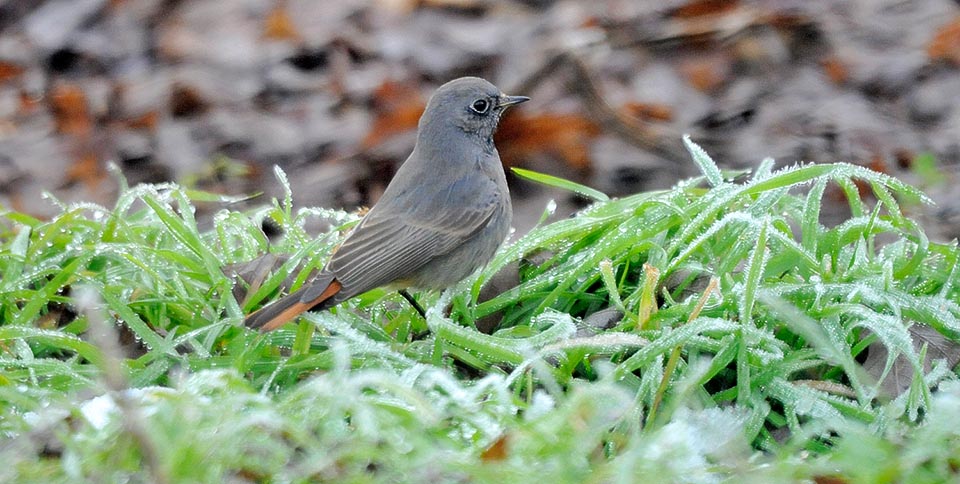
Female at ease among the frost. The Phoenicurus ochruros is less sensitive to cold than Phoenicurus phoenicurus but when cold often moves southward © G. Colombo
The stay in the nest may vary significantly depending on the necessities and the security offered by the shelter but usually after about fifteen days the chicks begin kicking and after a few days more they take off. Usually the female performs two broods per year. It is a species parasitized by the cuckoo.
The black redstart is purely insectivorous during the reproductive season and nourishes of terrestrial as well as of flying invertebrates: insects with relevant larvae, spiders and worms. In autumn and in winter it integrates the diet with vegetal alimentation based on fruits and small seeds. The city populations, much more evolved, do not disdain some morsels offered by the man while jumping, always with the utmost care, on the windowsills or in the well-stocked mangers. Also this a sign of evolution.
It is not an endangered species, seen the vastity of the territory occupied and the good consistency of the various populations. Like all small birds they are object of predation by falconets and night raptor to which have added the domestic cats for the city populations. Of course, also this is evolution!
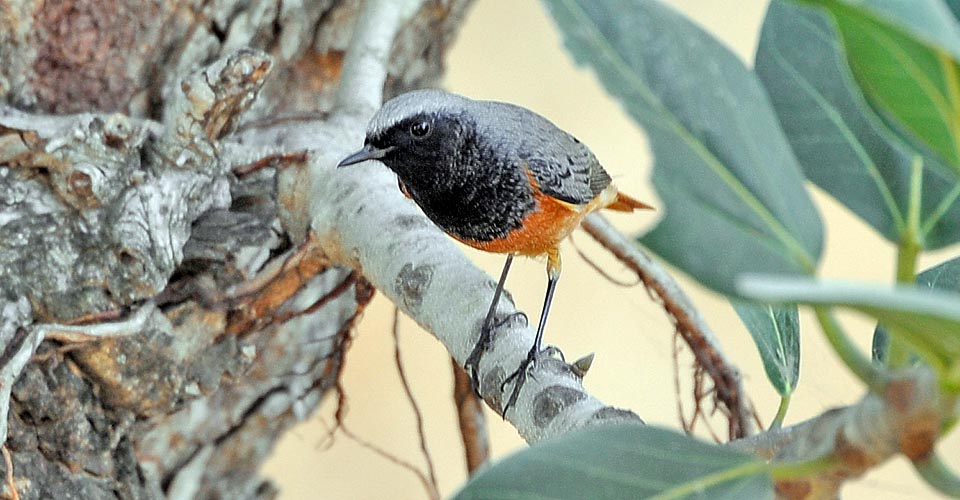
In the Asian range exist subspecies like the Phoenicurus ochruros rufiventris and the Phoenicurus ochruros phoenicuroides with orange red belly and chest in the males. Seen the vastity of the territory occupied, the increasing anthropization and the good consistency of populations, the black redtsart is surely not an endangered species © Gianfranco Colombo
→ To appreciate the biodiversity within PASSERIFORMES please click here.
